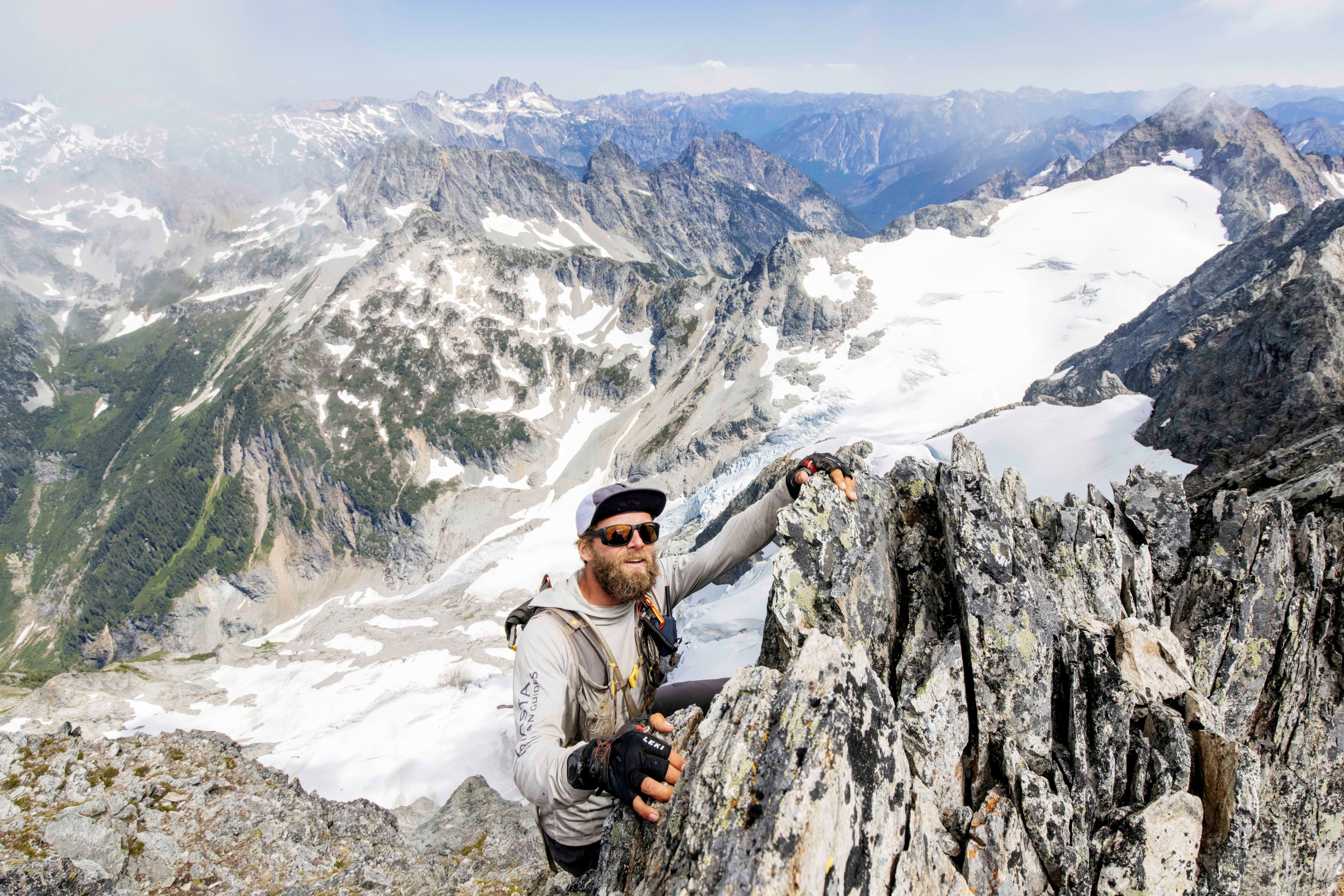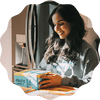An Oregon school teacher makes mountaineering history amongst the peaks of Washington State.

Jason Hardrath climbs ever upwards through the surrounding haze. The swirling clouds leave a cool dampness on his skin. He moves fluidly; focus dialed down to only that which is in front of him. Foot here, hand there, grab this rock, the other foot moves. His world is quiet. It’s just him and the rock.
He breaks above the clouds before he reaches the summit, but still, his focus is honed in on the task in front of him. The earth falls away to a sea of clouds as he crests onto the summit. The puffy white layer below seems almost thick enough to walk on. His awareness widens and he breathes it in, this world that seems to only belong to him.
This is not Hardrath’s first peak, nor is it his last. This is peak number 44, Sinister Peak, in what was a 50-day push to summit all of Washington State’s 100 highest peaks, called the Bulger List. This astounding feat took him across 869 miles of the state’s roughest terrain and totaled over 411,000 feet of climbing. Hardrath bushwhacked, hiked, scrambled, and climbed through dense vegetation, boulder fields, glaciers, talus fields, and scree. He met incredible people along the way, and connected with nature and himself.
The Bulger list is an iconic list of peaks put together by a mountaineering group of the same name in 1980. Since its inception, the list has only seen 84 finishers, most of whom took four years or more to complete. In 2018, Eric Gilbertson set the speed record in 410 days, climbing peaks in between life’s usual responsibilities. But Hardrath saw the possibility of completion in 100 days or less, and being a school teacher, he would only have a summer available to give it a shot.
Fastest Known Time
The pursuit of a speed record on the Bulger list came as part of a much larger project. Hardrath started running Fastest Known Times (FKTs) in 2018 as a way to satisfy his craving for adventure and creativity, and to utilize his skills as a runner, mountaineer, and rock climber. At the most basic level, FKTs are speed records on established routes. The routes can vary substantially in form and distance, ranging from mountains to beaches to towns and city parks and everything in between. Routes must be repeatable and considered a “classic route” for the area.

Early on in his FKT career, Hardrath set a goal to be the first person to achieve 100 of these speed records. Setting this specific goal for himself lit a fire that sent him all across the Western United States in search of unique routes that could test him. While Hardrath certainly has an affinity for the mountains, his pursuit of FKTs has taken him through the canyons of Utah, across deserts in Nevada, and has sent him soloing up numerous rock formations in popular climbing areas such as Smith Rock in Oregon and Red Rock Canyon in Nevada.
As Hardrath neared the 100-mark, people began to wonder; What will number 100 be? “People seem to be drawn to these big round numbers, particularly 100,” he says. “As silly as it seems, climbing 100 peaks for my 100th FKT just felt right. It was almost too poetic.”
Not only was the pursuit of 100 mountain summits an elegant way to cap off his crazy pursuit, but it was also a way to bring together all of the skills he had learned throughout his FKT journey. “It just felt like this sort of cumulative exam of everything I'd done before,” says Hardrath. “This was the final test to get to number 100.”
Focus and Clarity in the Mountains

Hardrath is no stranger to strenuous athletic pursuits. He grew up playing sports and setting audacious goals for himself. As a middle-schooler, Hardrath set a goal to run a sub-six-minute mile. He worked tirelessly to reach that goal, and when he did, decided that track was something he could excel in.
“I was the ADHD kid who couldn’t sit still,” he says. “Moving my body was, and still is, integral to my functioning on a day-to-day basis. Running was something that I could get good at. It helped me set goals, and in order to achieve those goals, forced me to focus.”
Hardrath eventually went on to run track at the collegiate level. Then, post-college, he found a new passion as a triathlete, putting in intense training weeks for full Ironman distances and qualifying for the Ironman World Championships in 2015.
Just a few months before the race, Hardrath nearly lost everything when he was ejected from a vehicle in a rollover accident. He broke nine ribs, shredded his ACL and LCL, and suffered a collapsed lung. The doctors told him that he’d have to let the athlete part of his life go and that he’d likely never run again. Hardrath wasn’t about to take their advice though.
With limited range of motion in his right knee, Hardrath found that hiking hills was the exercise that worked best. “I started off doing laps on the local training hill. That led to mountains, which led to bigger mountains. I eventually found myself setting large goals and learning mountaineering skills and rock climbing skills in order to accomplish the objectives I set out to achieve.”
Hardrath found peace in the mountains and in technical climbing, saying that, “All of the chatter and business and distraction in my mind due to my ADHD cognition disappears when I’m climbing in the mountains. I can just focus and be in the moment and play.”
It Takes a Village
Since climbing the 100 tallest peaks of Washington had never been done in a single season before, Hardrath had what most people would consider a logistical nightmare in front of him. Between gathering and memorizing climbing routes, creating peak linkups, making a nutrition plan and a support crew strategy, it took a total of about six months to put the logistics for the adventure together.
He reached out to a select few who had either already finished the Bulgers List or were close to finishing. Alden Grant Ryno, Matt Lemke, and then record holder Eric Gilbertson were the main contributors to the planning process. Ryno remained available throughout the duration of the effort to help with sudden logistical issues.
On the first day of the FKT attempt, Hardarth was joined by then 21-year-old climber and ultra-endurance athlete, Nathan Longhurst. They had so much fun in the mountains on that first 47-mile day that Longhurst decided to stick around. The duo ended up climbing more than 60 of the peaks together, and as a result, the youthful athlete became the youngest person to finish the Bulger List and the second person to ever complete it within a single season.

“We were able to find a perfect balance of moving efficiently while keeping just enough in the reserves to get back on our feet the next day,” says Longhurst. “We became very familiar with each other’s idiosyncrasies and quirks, reaching a point where we rarely had to verbally discuss route-finding, scree-dodging, joy or pain. Life was blissfully simple.”
It was extremely important to Hardrath to make sure to follow all laws and wilderness regulations, obtain all appropriate permits, and to respect all fire closures during the Bulgers FKT. This would not only ensure that his speed record is legitimate, but it would also mean that he did it in good style; something that Hardrath deemed critical as a contributor to the history of mountaineering in Washington. “I wanted to do right by the Pacific Northwest Mountaineering community,” he says.
This meant that some of the approaches to a few of the peaks were more difficult due to fire closures from previous years. It also meant that he couldn’t stay the night in certain wilderness areas because he couldn’t get overnight permits, such as in the Enchantments, so he had to hike out in the evening and return in the morning.
A Lifetime of Memories

The Northern Cascades left a huge mark on all of those involved. Hardrath came away from the experience with a deep love and respect for the remote peaks of the Cascades, as well as a new appreciation for what the human body is capable of. “If I could go back in time knowing what I know now and do it again, I absolutely would,” he says. “It was a grand adventure that I’ll be learning from for the rest of my life. It pushed me as an athlete, a human, and a partner.”
Would he do it a second time though? “Probably not,” he says. “I have a deep sense of satisfaction with how everything went. It was hard work, well done.”
Going forward, Hardrath will be using this and his other adventures as inspiration for his students. He wants them to see that having an ADHD cognition can be somewhat of a superpower, and that if they set big goals, they have the capacity to achieve them.
“I always tell my students to dream big and not let setbacks get them down,” he says. “When we have something in front of us that feels possible, but also feels scary, and we feel both excited and scared at the same time, then that's the direction we should go. I have to live that in order to be authentic.”
Journey to 100 Film

You will now have the opportunity to watch this amazing story unfold on the big screen. Find out where and how you can see the Journey to 100 film here.




























 Your Privacy Choices
Your Privacy Choices











